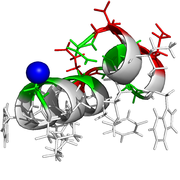


Peptide-membrane interactions are highly relevant for a number of diseases and therapies. Antimicrobial peptides often penetrate membranes to form pores, viral infections begin with peptides interacting with host cell membranes, and amyloidogenic diseases often involve peptide-membrane interactions as part of pathological developments.
We are using computer simulations, and in particular implicit membrane models, to study the complex dynamics of membrane-interacting peptides. So far we have focused in particular on phospholamban, a regulator of the heart muscle calcium pump SERCA, and viral fusion peptides.
| 2015 | ||
| 5. | Vahid Mirjalil, Michael Feig: Interactions of Amino Acid Side-Chain Analogs within Membrane Environments Journal of Physical Chemistry B (2015) 119, 2877-2885 Abstract PDF | |
| 2013 | ||
| 4. | Maryam Sayadi, Michael Feig: Role of Conformational Sampling of Ser16 and Thr17-phosphorylated Phospholamban in Interactions with SERCA BBA Biomembranes (2013) 1828, 577-585 Abstract PDF | |
| 2011 | ||
| 3. | Adam Jaskierny, Afra Panahi, Michael Feig: Effect of flanking residues on the conformational sampling of the internal fusion peptide from Ebola virus Proteins (2011) 79, 1109-1117 Abstract PDF | |
| 2010 | ||
| 2. | Afra Panahi, Michael Feig: Conformational Sampling of Influenza Fusion Peptide in Membrane Bilayers as a Function of Termini and Protonation States Journal of Physical Chemistry B (2010) 114, 1407-1416 Abstract PDF | |
| 1. | Maryam Sayadi, Seiichiro Tanizaki, Michael Feig: Effect of membrane thickness on conformational sampling of phospholamban from computer simulations Biophysical Journal (2010) 98, 805-814 Abstract PDF |